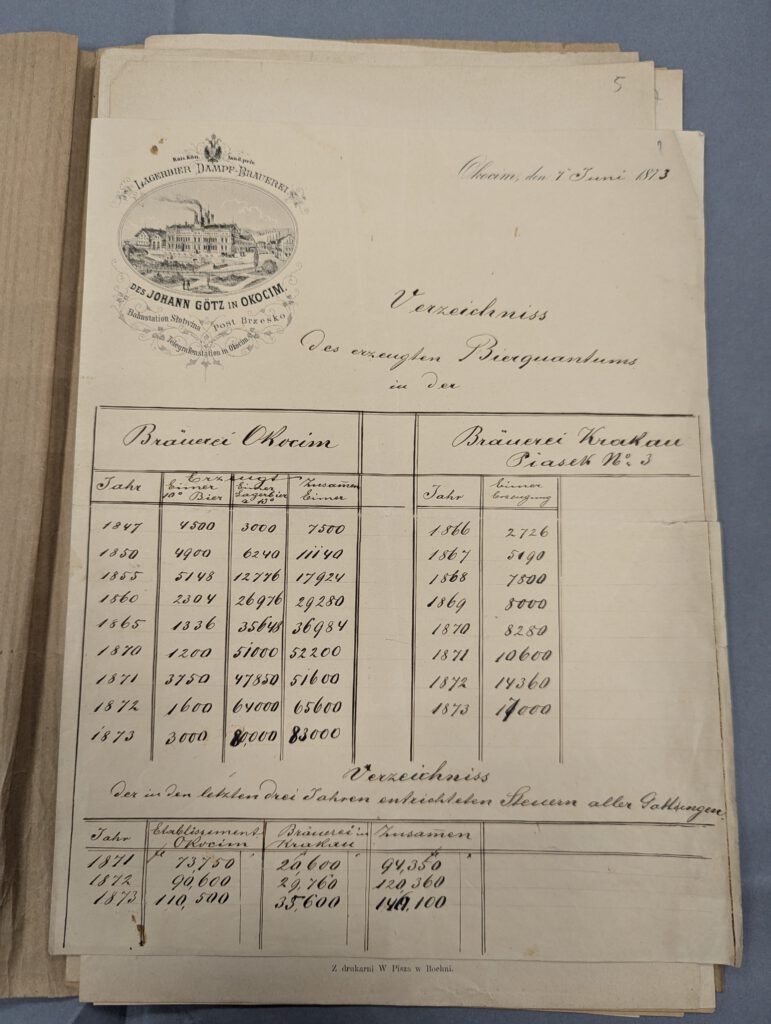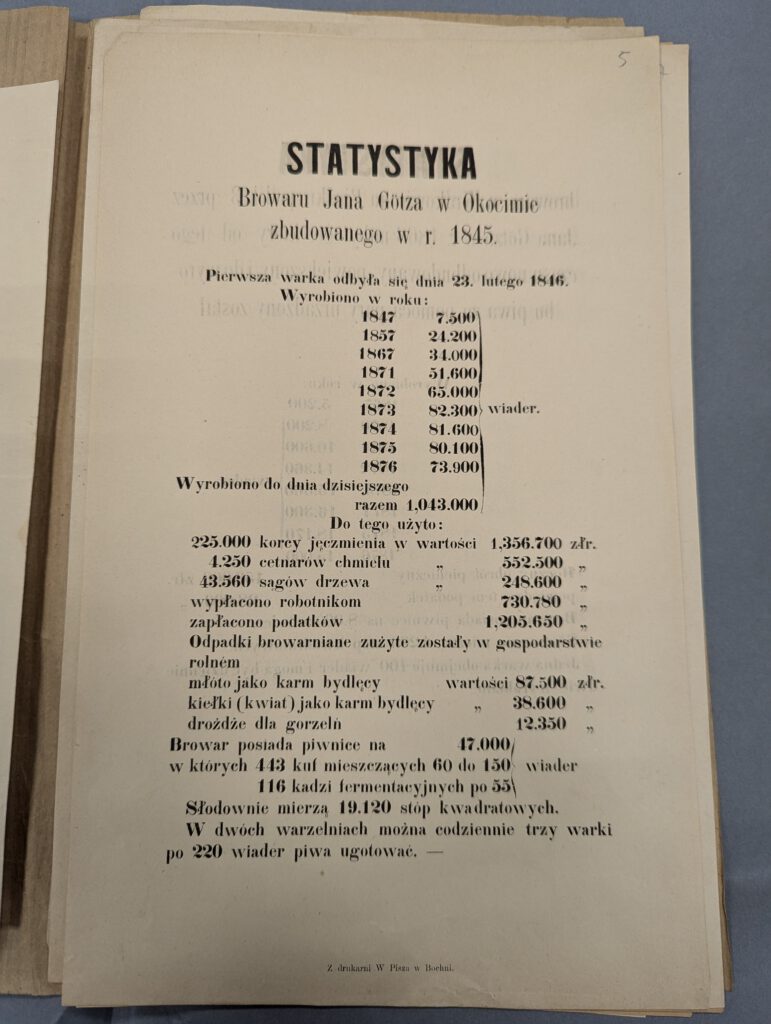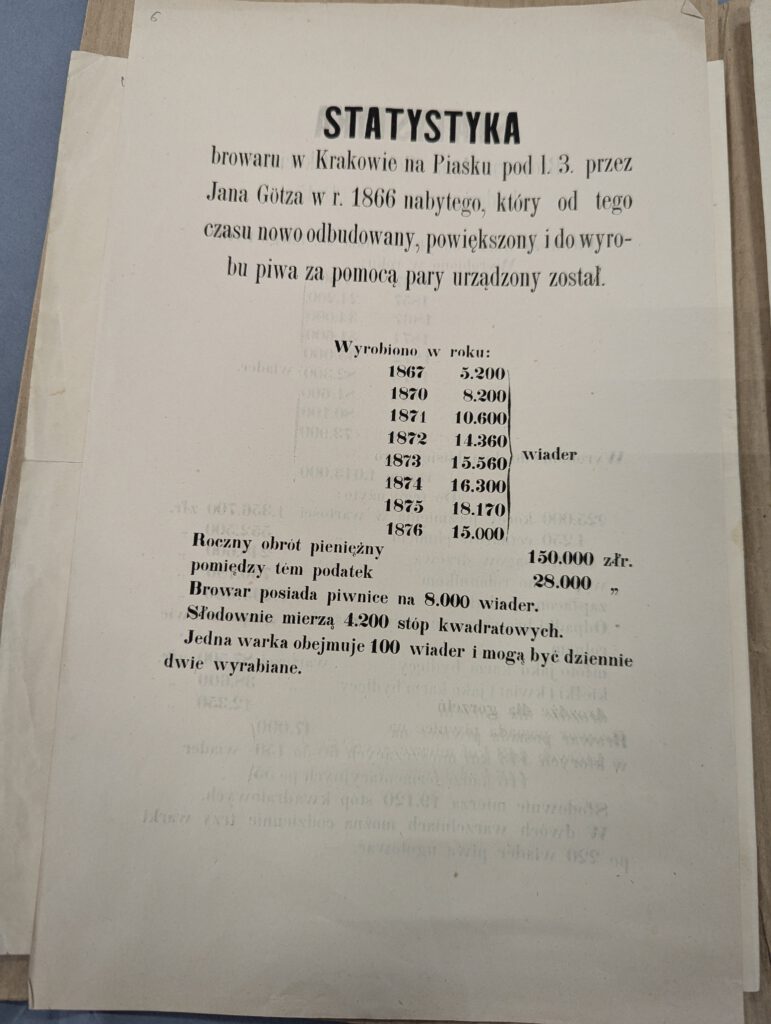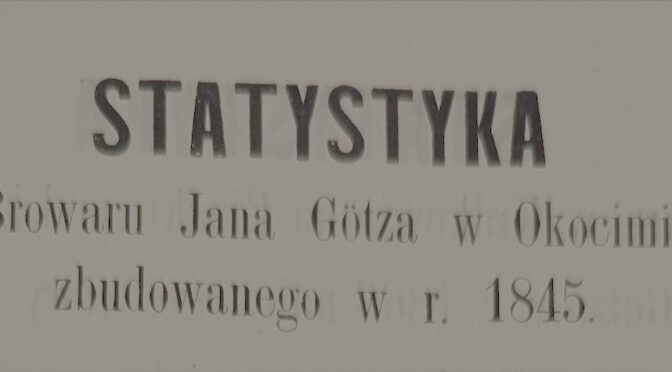On my visit to the National Archives in Kraków, I came across quite a bit of material related to Johann Götz and his breweries. So who’s Johann Götz anyway, and what makes his breweries relevant?
Johann Evangelist Götz, or Jan Ewangelista Götz (sometimes spelled Goetz) as he’s called in Polish, was born in 1815 in Langenenslingen in modern-day Baden-Württemberg. Coming from a family of brewers, he was hired as a cellar master in 1837 at the Kleinschwechater brewery by Anton Dreher, who happened to be his cousin. After 1.5 years, he was promoted to brewery foreman and Dreher’s personal assistant. He was closely involved in brewing the first “real” Kleinschwechater Lager in 1840, and has been credited with improved the quality of the beer as well as the brewery’s overall efficiency. He was an important figure in the history of Vienna Lager, but his stint at Kleinschwechat was relatively short, as he moved to Galicia in 1845 where he co-founded the Okocim brewery not far from Kraków.
At a time when bottom-fermentation was still only catching on in Vienna and bakers started to feel a lack of availability of barm (brewer’s yeast, skimmed from fermenters of top-fermented beers), he went to the easternmost realms of the Austrian Empire and started a new, industrial brewery using the techniques he helped develop and perfect together with Anton Dreher. In doing so, he was (to my knowledge) the first one to establish a lager brewery in partitioned Poland.
Besides the brewery in Okocim, he also started another brewery in Kraków, in the Piasek district. One find I was very happy about when I went through the material in the National Archives was a German-language hand-written list of production statistics for both breweries. Though they were not quite complete for all years, they still give us great insight into the overall development and growth of both breweries.
Here are the statistics for the Okocim brewery by year. All amounts are in Eimer. One Eimer equals 56.589 liters, or about 0.566 hl. I added the equivalent hl in parentheses.
| Year | 10° Beer | 13° Lager Beer | Combined |
| 1847 | 4,500 (2,546) | 3,000 (1,698) | 7,500 (4,244) |
| 1850 | 4,900 (2,773) | 6,240 (3,531) | 11,140 (6,304) |
| 1855 | 5,148 (2,913) | 12,776 (7,230) | 17,924 (10,143) |
| 1860 | 2,304 (1,304) | 26,976 (15,265) | 29,280 (16,569) |
| 1865 | 1,336 (756) | 35,648 (20,173) | 36,984 (20,929) |
| 1870 | 1,200 (679) | 51,000 (28,860) | 52,200 (29,539) |
| 1871 | 3,750 (2,122) | 47,850 (27,078) | 51,600 (29,200) |
| 1872 | 1,600 (905) | 64,000 (36,217) | 65,600 (37,122) |
| 1873 | 3,000 (1,698) | 80,000 (45,271) | 83,000 (46,969) |
One interesting detail here is how the brewery produced both a 10° beer and a 13° beer (the degrees refer to the original gravity in Balling). This is something we know from Anton Dreher’s brewery, where these two beer strengths were the two main beers brewed at least until the 1890s. Distinguishing beers by OG is also still common in Czechia, though the main strengths there are more commonly 10° and 12°.
It is noticeable though that while the 10° beer was a relatively large share of the overall production in early years, it never grew beyond slightly more than 5,000 Eimer per year, and within 26 years the share of 10° beers in the overall production volume shrank from 60% to just 3.75%. I guess lower-strength beers weren’t particularly popular among Poles at the time…
In the same document, we also get statistics for Götz’s brewery in Kraków. Again the amounts are in Eimer, which the equivalent hectoliter in parentheses next to it.
| Year | Amount |
| 1866 | 2,726 (1,542) |
| 1867 | 5,190 (2,937) |
| 1868 | 7,800 (4,414) |
| 1869 | 8,000 (4,527) |
| 1870 | 8,280 (4,685) |
| 1871 | 10,600 (5,998) |
| 1872 | 14,360 (8,126) |
| 1873 | 17,000 (9,620) |
Clearly, the Kraków brewery was producing at a much smaller scale. But still, at a combined 100,000 Eimer (56589 hl) for 1873, this was a sizeable brewing operation divided between locations.

I then also came across printed statistics (in Polish) from a few years after that lists production statistics up to 1876, plus many more details about the equipment and capacity of the Okocim brewery:
| Year | Amount |
| 1847 | 7,500 (4,244) |
| 1857 | 24,200 (13,694) |
| 1867 | 34,000 (19,240) |
| 1871 | 51,600 (29,200) |
| 1872 | 65,000 (36,783) |
| 1873 | 82,300 (46,573) |
| 1874 | 81,600 (46,177) |
| 1875 | 80,100 (45,328) |
| 1876 | 73,900 (41,819) |
In addition to that, we learn more about the brewery capacity: the malting floor had a size of 19,120 square foot (the foot used was probably the Wiener Fuß of about 316mm). The brewery had two brew houses, each of which could produce 3 turns of 220 Eimer each per day, so a theoretical capacity of up to 1,320 Eimer (747 hl) per day in total. Fermentation happened in 116 vats with a capacity of 55 Eimer each, while the lagering cellar held 443 lagering casks of 60 to 150 Eimer each, for a combined total of 47,000 Eimer of beer that could be lagered at once.

And similar information the branch in Kraków:
| Year | Amount |
| 1867 | 5,200 (2,943) |
| 1870 | 8,200 (4,640) |
| 1871 | 10,600 (5,998) |
| 1872 | 14,360 (8,126) |
| 1873 | 15,560 (8,805) |
| 1874 | 16,300 (9,224) |
| 1875 | 18,170 (10,282) |
| 1876 | 15,000 (8,488) |
Both malt house and brew house were considerably smaller there: the malting floor only had a size of 4,200 square foot, and only one brewing system was in place that could produce 100 Eimer per turn, with up to 2 turns per day. The lagering capacity was also significantly smaller, with only 8,000 Eimer.


